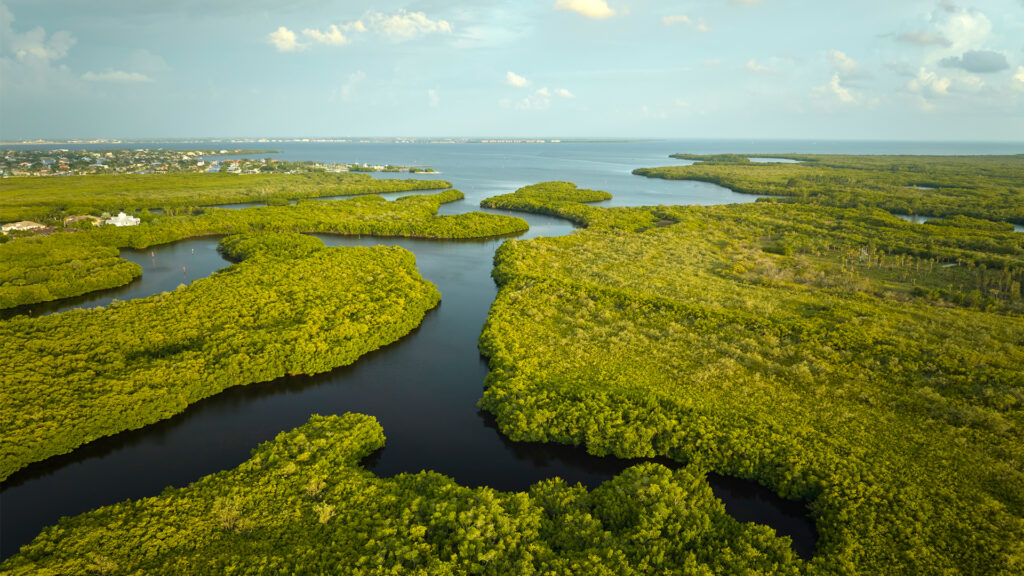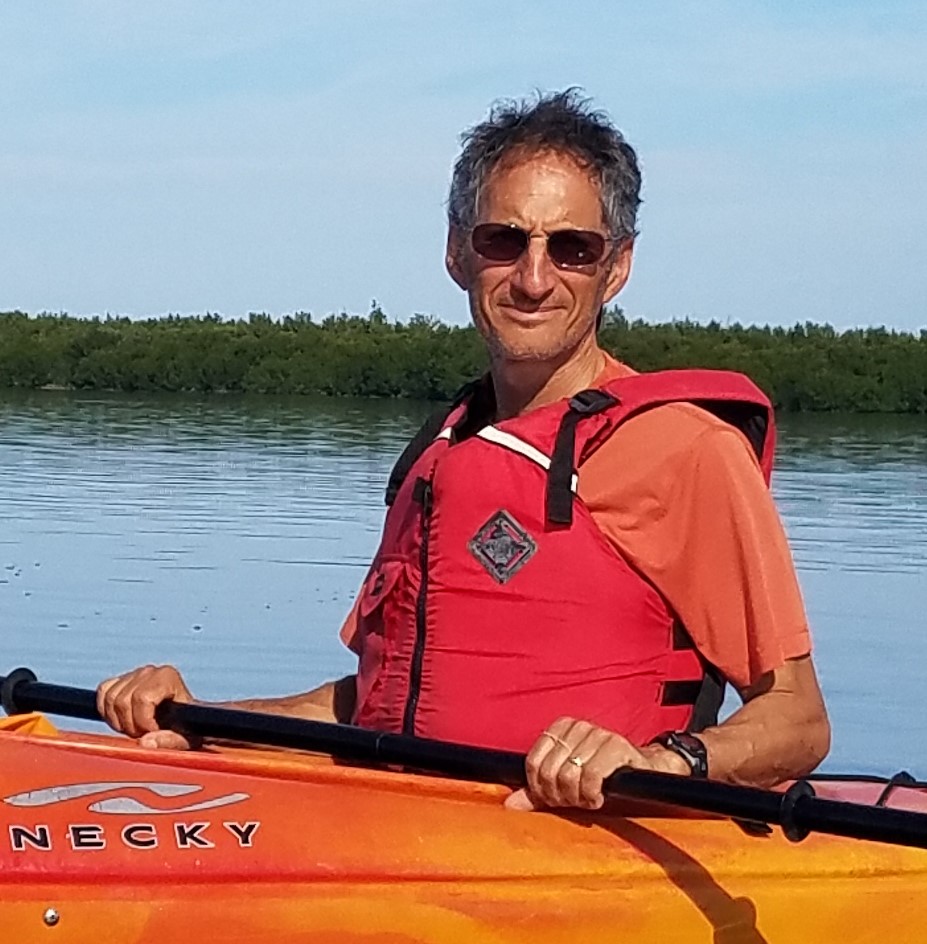By Joseph Bonasia, Florida Rights of Nature Network
When it comes to dealing with climate change — which is primarily a water crisis of worsening floods, rising sea levels, wildfires and droughts — water is a “super-power.”
The final declaration of the United Nations climate change conference known as COP27 recognized “the critical role of protecting, conserving and restoring water and water-related ecosystems in delivering climate adaptation benefits and co-benefits, while ensuring social and environmental safeguards.”
We will not deal effectively with climate challenges if we do not limit our use of fossil fuels, but neither will we be fully effective if we don’t harness the power of aquatic ecosystems to heal our planet.

Coastal blue carbon is gold
Technological efforts to sequester carbon from the atmosphere and store it in the Earth are prohibitively expensive and unproven. That is not so for Mother Nature.
Coastal blue carbon is carbon stored by saltwater ecosystems in their vegetation and soils. When it comes to sequestering and storing significant amounts of carbon, coastal wetlands are powerhouses.
The National Oceanic and Atmospheric Administration reports that “mangroves and coastal wetlands annually sequester carbon at a rate ten times greater than mature tropical forests. They also store three to five times more carbon per equivalent area than tropical forests.”
Thus, Florida’s potent means of reducing greenhouse gases and mitigating the effects of climate change (worsening floods, droughts, wildfires, etc.) is its wetlands, especially its coastal wetlands.
When wetlands are destroyed, however, not only do we lose their important sequestration capabilities, but the carbon they have long stored is released and adds to greenhouse gas levels in the atmosphere: a double climate whammy.
But that is not the full story, either.
I live in Cape Coral in Southwest Florida. We were hit hard by Hurricane Ian and my home suffered $120,000 of damage, mostly caused by storm surge. Cape Coral is one of nine cities most at risk from future storms, so residents want as much storm protection and flood mitigation as we can get. Again, Mother Nature provides if we let her.
A Nature Conservancy-funded study showed that annually, across multiple storms, Florida’s mangroves reduce flood damages by 25.5% to properties behind them. During Hurricane Irma, over 626,000 people living behind mangrove forests saw reduced flooding and mangroves averted $1.5 billion in surge-related flood damages to properties.
Finally, wetlands, of course, also offer valuable water filtration services, shoreline erosion protection, and serve as crucial fish and wildlife habitat. Wetlands are invaluable natural wonders.
Unfortunately, they are under attack. Even though Florida has already lost 9.3 million acres, rampant development continues to gobble up more wetlands, thus exacerbating our climate crisis. Developers, with the aid of our state legislature that passes egregious laws like the sprawl law of 2023, will not stop until we stop them.
Blue-green algae: methane menace
Methane is 60 times more powerful an agent of climate change than carbon. People know flares from oil rigs release harmful amounts of methane into the atmosphere and that cattle flatulence is a considerable source of methane, too.
Few people realize that blue-green algae produces a relevant amount of methane, contributing to global warming, which in turn warms waters which breeds more algae blooms, emitting more methane, a vicious cycle.
Florida is plagued with blue-green algae blooms. Every year Lake Okeechobee is covered with hundreds of square miles of it, as is the case now. Too often, through water releases, it spreads to Southwest and Southeast Florida coastal waters as it did in 2013, 2016 and 2018, threatening people with short- and long-term illness and choking local economies.
A constitutional right to clean and healthy waters

By failing to protect our waters and aquatic ecosystems, our state government undermines our ability to confront the climate crisis that poses such an enormous threat to Floridians. This is where the proposed “Right to Clean and Healthy Waters” state constitutional amendment can be of great help. By enabling us to hold state agencies accountable for the degradation of aquatic ecosystems, we can protect our wetlands and curtail harmful algal blooms.
In its purpose statement, the amendment language specifically addresses “aquatic ecosystem services including carbon storage, water filtration, and risk mitigation for drought, erosion, and floods,” and includes in the definition of waters, “the aquatic ecosystems of aquifers, bays, creeks, estuaries, estuarine systems, lagoons, lakes, rivers, riverine systems, springs, streams, wetlands, and intracoastal and coastal waters within the boundaries of the State of Florida.”
Water and climate are inextricably connected. Taking care of water now helps us take care of Earth’s climate for ourselves and future generations.
Joseph Bonasia is chair of the Florida Rights of Nature Network. Registered voters can sign the “Right to Clean and Healthy Waters” petition at FloridaRightToCleanWater.org.
If you are interested in submitting an opinion piece to The Invading Sea, email Editor Nathan Crabbe at ncrabbe@fau.edu. Sign up for The Invading Sea newsletter by visiting here.




Excellent article. Thank you for submitting it. Yes, methane is a worse gas than carbon considering the greenhouse effect.
Also, our wetlands are extremely valuable and enough have been mitigated. Thanks again.
Algae blooms are known to be caused by excess use of phosphorus based herbicides and fertilizers. Excess phosphorus causes water to become acidic and reduces the amount of oxygen in the water. Reduced oxygen levels results in the growth of toxic and pathogenic microorganisms which all thrive in low oxygen environments. Healthy water requires water with high oxygen levels. All pollutants cause reduced oxygen levels in the water. What global warming alarmists don’t tell people is that sulfur dioxide causes global cooling and that 99% of the atmosphere is made up of 78% nitrogen and 21% oxygen with only 1% of the atmosphere being made up of other gases and water vapor.
https://www.encyclopedia.com/science-and-technology/chemistry/compounds-and-elements/sulfur-dioxide
https://19january2021snapshot.epa.gov/so2-pollution/sulfur-dioxide-basics_.html
https://so2.gsfc.nasa.gov/so2intro.html
https://volcano.oregonstate.edu/climate-cooling
https://www.usgs.gov/programs/VHP/volcanoes-can-affect-climate
https://temperatures.com/weather-and-climate/substances-that-can-reduce-air-temperatures-following-a-volcanic-eruption/
https://www.epa.gov/national-aquatic-resource-surveys/indicators-phosphorus
https://theconversation.com/explainer-what-causes-algal-blooms-and-how-we-can-stop-them-109646